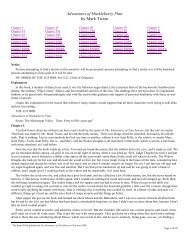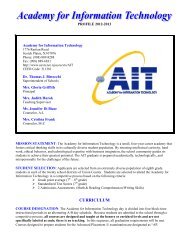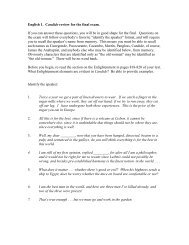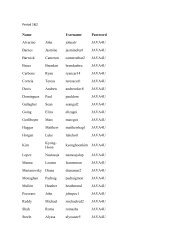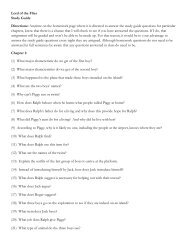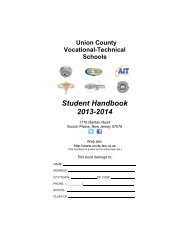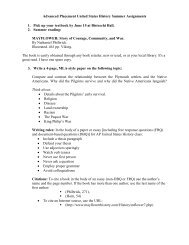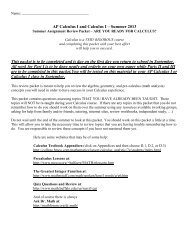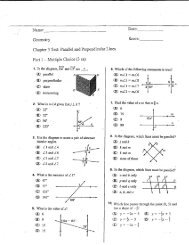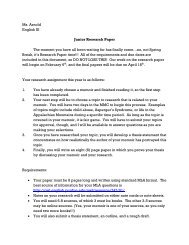AP® Physics C: Mechanics
AP® Physics C: Mechanics
AP® Physics C: Mechanics
Create successful ePaper yourself
Turn your PDF publications into a flip-book with our unique Google optimized e-Paper software.
UC AIT AP ® <strong>Physics</strong> C: <strong>Mechanics</strong><br />
Academic Year 2011-2012<br />
Description<br />
AP <strong>Physics</strong> C: <strong>Mechanics</strong> is a rigorous college-level course designed to be equivalent to the first semester of a typical college<br />
sequence in physics for science and engineering majors. Major areas of study include kinematics, forces and motion, work and<br />
energy, systems of particles, rotational dynamics and statics, gravitation, and oscillations. The curriculum is designed to prepare<br />
students for the AP <strong>Physics</strong> C: <strong>Mechanics</strong> exam, which the College Board offers in May. Calculus is used throughout the course to<br />
unify concepts and develop the theoretical framework for the course.<br />
In this course, students will develop their critical thinking and problem solving skills in a variety of ways. Understanding concepts<br />
and connections will be emphasized over memorizing equations. Homework and in-class activities will offer students opportunities<br />
to apply physics knowledge in new and meaningful ways. Students will utilize technology, from computer simulation and data<br />
analysis software to calculator and computer data collection equipment, in order to connect the physics they are studying to realworld<br />
situations.<br />
Students will learn to clearly communicate their scientific work, a critical skill for today’s workplace, through work in small<br />
cooperative groups, presentations of projects, homework problem solutions, and writing lab reports. This course will include a<br />
variety of activities to reach students with varied learning styles, including several cooperative group activities to help students<br />
solidify their own physics knowledge by teaching their peers.<br />
Prerequisites<br />
Any student who has completed <strong>Physics</strong> 1 Honors with a final grade of 90% or above and is concurrently taking AP Calculus AB<br />
may register for AP® <strong>Physics</strong> C: <strong>Mechanics</strong>.<br />
Textbook and Materials<br />
1. Each student is issued a copy of the textbook: <strong>Physics</strong> for Scientists and Engineers (with <strong>Physics</strong>NOW and InfoTrac) 6 th or 7 th edition by<br />
Raymond A. Serway and John W. Jewett.<br />
2. Students will have access to a copy of Interactive <strong>Physics</strong> 5 (Design Simulation Technologies). We use this software for classroom<br />
demonstrations and for the enrichment purpose of simulation of chosen homework assignments throughout the year.<br />
Each student should obtain:<br />
1. A three ring loose-leaf binder with dividers and loose leaf paper for exclusive use in this course. All quizzes, tests, handouts,<br />
homework, class notes and laboratory reports should be kept in this binder.<br />
2. A separate lab journal notebook to maintain a record of all laboratory notes, data and reports.<br />
3. A scientific calculator. A limited supply of TI-89 calculators will be available for in-class use.<br />
Summer Assignment<br />
All students will be given an assignment over the summer break (prior to our first class meeting). Students will be given a quiz on<br />
this material at the end of the first week of school.<br />
Assessment<br />
Tests are given for every <strong>Physics</strong> C: <strong>Mechanics</strong> unit. The tests are purposely similar in construction to the AP Exam. Each test consists<br />
of 7-15 multiple-choice questions and 1-2 free response questions similar or identical to released AP <strong>Physics</strong> C: <strong>Mechanics</strong> exams.<br />
There is a midterm exam given in January and a final exam given in May before the actual AP exam. Both the midterm and final<br />
exams are designed to be as similar as possible to the AP exam format and content.<br />
Grading<br />
The final grade for the course consists of the four marking period grades, worth 20% each, and midterm and final examination (and<br />
project), worth 10% each. A final grade of 65% is required to successfully pass the course. Marking period grades are calculated as<br />
follows (20% of final grade per marking period):<br />
Tests, quizzes, graded assignments 70%<br />
Lab reports 15%<br />
Graded Homework (see grading rubric in Class Expectations handout) 10%<br />
Class Participation and conduct 5%<br />
UC AIT AP <strong>Physics</strong> C: <strong>Mechanics</strong> Syllabus
Homework<br />
Homework is assigned daily via whiteboard and recorded on my teacher website. Homework assignments are always checked for<br />
completion as well as collected once every 2 weeks to be scored and graded. All homework exercises are reviewed thoroughly in<br />
class. This methodology encourages students to stay current in their assignments.<br />
Laboratory Requirements<br />
Hands-on laboratory experience is a fundamental part of the course. Approximately 20 percent of class time will be spent on<br />
laboratory work. Considerably more time will be required outside of class to prepare laboratory reports and lab journal. Students<br />
will be required to keep and maintain a laboratory journal. The purpose of the journal is twofold. First, it is a record of all lab work<br />
done for the year. Students will be able to use the lab journal as a reference for the remainder of the year and during college if the<br />
student takes further physics courses. The second purpose is to further persuade that specific colleges will award the student full<br />
credit for the course.<br />
<strong>Physics</strong> C: <strong>Mechanics</strong> Labs<br />
Lab #1 One Dimensional Kinematics, Lab #2 Projectile Motion, Lab #3 Friction, Lab #4 Work done by a Variable Force, Lab #5 Work<br />
and Energy, Lab #6 Impulse and Momentum, Lab #7 Elastic and Inelastic Collisions, Lab #8 Rolling Down a Hill, Lab #9 SHM,<br />
Lab #10 Pendulums, Lab #11 Final project<br />
<strong>Physics</strong> C: <strong>Mechanics</strong> Topics and Coverage<br />
<strong>Physics</strong> C: <strong>Mechanics</strong> is covered through the entire school year (September through May). Concepts and problem-solving techniques<br />
are introduced through a combination of lectures, physical and simulation demonstrations, and problem solving sessions (“problem<br />
days”). The text is our main resource, with previous AP exam multiple choice and free response questions used as concept<br />
summative exercises. Calculus is used throughout our problem solving and most notably during lecture sessions where we will go<br />
through derivations of equations that students have used (but not derived with Calculus) previously in <strong>Physics</strong> 1 Honors.<br />
1. Introduction, Vector Mathematics, Calculus<br />
2. Kinematics<br />
3. Newton’s Laws of Motion<br />
4. Work, Energy, Power<br />
5. Systems of Particles and Linear Momentum<br />
6. Circular Motion and Rotation, Uniform Circular Motion, Rotational Dynamics, Angular Momentum<br />
7. Gravitation<br />
8. Oscillations and Simple Harmonic Motion<br />
I will expect you to:<br />
-Come to class on time and be ready to participate<br />
-Take responsibility for your actions<br />
-Be prepared to do significant work outside of class commensurate with a college level course of study<br />
-Show respect to others when they are talking by listening carefully and quietly<br />
-Show respect for school property as well as others’ property<br />
-Obtain missed notes from a classmate or teacher if you have been absent<br />
-Check the assignment website for missed assignments.<br />
http://www.ucvts.tec.nj.us/ucvts/AIT/Staff/Timothy%20Laverick<br />
-Ask questions and seek additional help from your teacher as needed<br />
-Do Your Best and Have Fun!<br />
Please feel free to contact me at tlaverick@ucvts.tec.nj.us or by telephone at 908-889-8288 extension 423 if you have any questions.<br />
UC AIT AP <strong>Physics</strong> C: <strong>Mechanics</strong> Syllabus
Please sign and return this form, please keep page 1-2 for your notebook<br />
- - - - - - - - - - - - - - - - - - - - - - - - - - - - - - - - - - - - - - - - - - - - - - - - - - - - - - - - - - - - - - - - - - - - - - - -<br />
UCAIT AP <strong>Physics</strong> C: <strong>Mechanics</strong> Syllabus 2011-2012:<br />
I have read and understood the course description, material requirements, grading policy, and expectations.<br />
Student Name (Print):__________________________________________________<br />
__________________________________<br />
Student’s signature<br />
____________________<br />
Date<br />
__________________________________<br />
Parent or Guardian’s signature<br />
_____________________<br />
Date<br />
Parent or Guardian preferred phone number: __________________________________<br />
Parent or Guardian preferred email address: ___________________________________<br />
UC AIT AP <strong>Physics</strong> C: <strong>Mechanics</strong> Syllabus
AP PHYSICS STUDY SKILLS<br />
<strong>Physics</strong> is not a spectator sport. You cannot expect to acquire the understanding you need to do well on an AP Exam by merely attending class<br />
and listening to the teacher. It requires your active participation in the learning process. You should ask questions such as "Why do we think<br />
this?" and "What would happen if we did this?" and if you can't answer them, seek the help of your physics teacher or other students.<br />
Having the opportunity to answer these questions by exploring phenomena and conducting experiments in the laboratory can often help you<br />
internalize the concepts and make them more concrete. Some computer simulations that allow you to set up hypothetical physical situations<br />
and observe the results of changing various<br />
quantities in the situations can also be helpful in developing conceptual understanding.<br />
When studying physics from a textbook, it is a good idea to have paper and pencil with you. You could review by working the details of<br />
solutions to example problems on your own. If you have completed the problems assigned by your teacher for homework and are still not sure<br />
of your understanding of the material, try some of the unassigned problems in the book on the same topic.<br />
Many students have the impression that physics is merely a list of formulas to be memorized and recalled at the proper time. Of course,<br />
formulas and equations are important in physics, but that is because physics is a science that deals with principles that can be expressed<br />
quantitatively. The equations are merely a way of expressing these principles. A feel for the physical reality behind the equations will help you<br />
remember them better than just trying to memorize a list.<br />
You must study regularly. In a physics course, many topics are based on preceding ones. Students who study regularly have the added<br />
advantage of being able to<br />
reinforce and enlarge on what they already know while tackling something new.<br />
The study of physics requires a high degree of concentration. Solutions to physics problems must be carried out carefully and in a precise,<br />
orderly manner. Be sure to draw a sketch of the problem in order to clarify what is being asked.<br />
If an error is made in a mathematical expression, it may be carried over to the following parts of the problem. Solve your problems in pencil,<br />
neatly and methodically. At every step of the analysis, be sure that you know your reason for taking the step. Write your answers with the<br />
appropriate units.<br />
PREPARING FOR THE AP PHYSICS EXAM<br />
Preparation for an exam is normally a cooperative venture between students and teachers, you should assume total responsibility for studying<br />
and learning the material presented in the course.<br />
Preparation for an AP Exam through independent study is also possible. If you exercise this option, the most important ingredient for success<br />
is strong self-motivation, although it would be extremely useful to have access to a teacher or tutor who can answer your questions and help<br />
you if you get stuck.<br />
The AP <strong>Physics</strong> examinations are given in May. To provide the most information about differences in students' achievement in physics, the<br />
examinations are designed so that students earn average scores of about 50% of the maximum possible score; this applies to both the multiplechoice<br />
section and the free-response section. Therefore, you may find AP Examinations more difficult than most classroom tests. However, it is<br />
possible for students who have studied most but not all of the topics in the outline to obtain acceptable test scores.<br />
Most AP students are accustomed to taking tests, both those prepared and graded by their teachers and standardized exams. Virtually<br />
everyone knows that regular study plus<br />
reviews of major elements in the course constitute the best preparation for tests. Effective study for examinations will vary somewhat among<br />
students. For example, many students find it helpful to study in a group with other students, while for others, group preparation may not<br />
work well. Some students can "cram" for a test, memorizing large amounts of material in a brief period of time just before the test. For others,<br />
cramming causes cognitive overload and exam-day confusion.<br />
If you want to master the skills and knowledge in your AP course, remember that material that is reviewed periodically and skills that are<br />
reinforced by practice are far more likely to remain with you than are those that are hastily acquired and partially digested over a brief interval<br />
of time.<br />
UC AIT AP <strong>Physics</strong> C: <strong>Mechanics</strong> Syllabus



